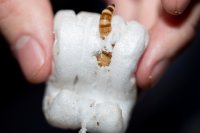
Bates students successful in bid to reduce acid rain
The Bates College Planeteers, a group of Bates environmental economics students, have successfully purchased an emissions permit good for one ton of sulfur dioxide in the 2001 Acid Rain Allowance Auction held annually by the Chicago Board of Trade. The group intends to retire the permit so that it can never be used, reducing the total amount of sulfur dioxide emissions this year by one ton.Bates College is one of eight schools to purchase a permit this year. The auction is part of the Environmental Protection Agency’s acid rain program, which has been very successful in reducing sulfur dioxide emissions and providing economic incentives for utilities that pursue cleaner technologies. The auction is a required part of the 1990 Clean Air Act.
“Here’s to economic incentives at work and a little less acid in Maine’s lakes,” said Lynne Bennett, associate professor of economics at Bates College. “This is something students will remember long after they leave Bates College and its text-book economics.”
Students researched the bidding process and proposed a bid amount with each student contributing $5 to the final bid amount of $191 made on March 20. The students learned of their successful bid, listening through a live Internet link, when the Chicago Board of Trade announced the bid results at press conference in late March.




